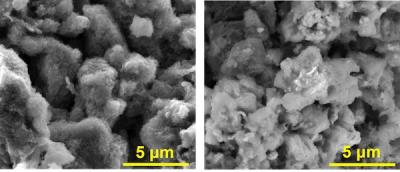Rice University scientists have developed highly efficient battery anodes using graphene and asphalt. To achieve this, the researchers mixed asphalt with conductive graphene nanoribbons and coated the composite with lithium metal through electrochemical deposition. The anodes showed exceptional stability after more than 500 charge-discharge cycles. A high-current density of 20 milliamps per square centimeter demonstrated the material’s promise for use in rapid charge and discharge devices that require high-power density.
 SEM images show an anode of asphalt, graphene nanoribbons and lithium at left and the same material without lithium at right
SEM images show an anode of asphalt, graphene nanoribbons and lithium at left and the same material without lithium at right
The capacity of these batteries is enormous, but what is equally remarkable is that we can bring them from zero charge to full charge in five minutes, rather than the typical two hours or more needed with other batteries, Prof. James Tour said.
Testing revealed another significant benefit: The carbon mitigated the formation of harmful lithium dendrites that often short-circuit the anode and cathode and can cause the battery to fail, catch fire or explode. The team notices that the asphalt-derived carbon prevents any dendrite formation.
An earlier project by the lab found that an anode of graphene and carbon nanotubes also prevented the formation of dendrites. According to Tour, the new composite is simpler. While the capacity between the former and this new battery is similar, approaching the theoretical limit of lithium metal, the new asphalt-derived carbon can take up more lithium metal per unit area, and it is much simpler and cheaper to make, he said. There is no chemical vapor deposition step, no e-beam deposition step and no need to grow nanotubes from graphene, so manufacturing is greatly simplified.



